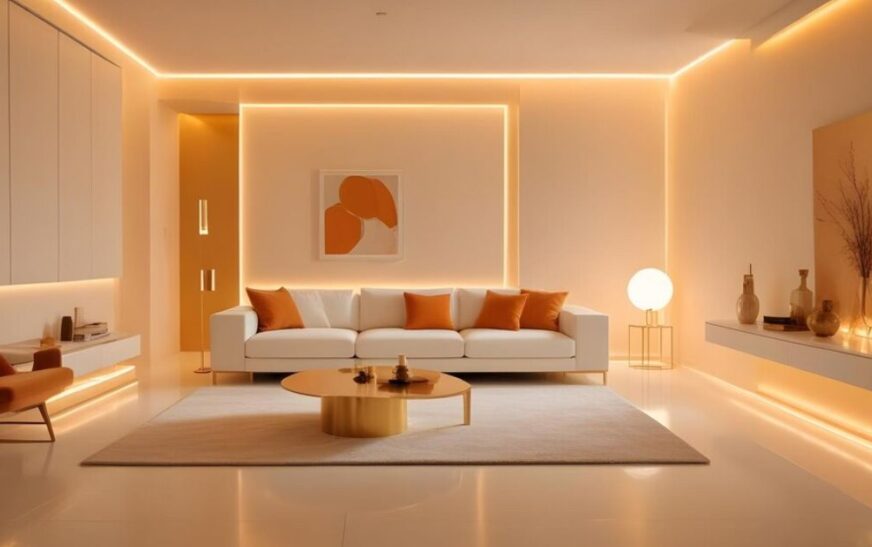Lighting is one of the most powerful tools in interior design. It can dramatically alter the mood, functionality, and aesthetic appeal of any space. Yet, it’s often an overlooked aspect of home décor. A well-lit room doesn’t just look good; it feels right. For interior designers in Chennai, mastering the art of lighting is crucial to creating spaces that are not only beautiful but also functional and inviting. In this blog, we’ll delve into the nuances of lighting design, exploring how to illuminate your home effectively.
The Importance of Lighting in Interior Design
Lighting is more than just a practical necessity; it’s a fundamental component of design. The right lighting can make a small room feel larger, create cozy nooks in spacious areas, and highlight architectural features or artwork. It sets the tone for a room, influencing how colors, textures, and furniture are perceived.
For interior designers, understanding the interplay between light and space is essential. Light can be used to draw attention to certain areas while subtly downplaying others. It can create depth, warmth, and even movement within a space. Effective lighting transforms a house into a home, making it more comfortable, functional, and aesthetically pleasing.
Types of Lighting: Layering for Success
One of the key principles of lighting design is layering. By combining different types of lighting, you can create a balanced and versatile environment. There are three main types of lighting that interior designers use:
- Ambient Lighting (General Lighting)
- Purpose: Ambient lighting provides overall illumination for a room. It’s the base layer of lighting that ensures the space is well-lit.
- Examples: Ceiling-mounted fixtures, chandeliers, recessed lighting, and floor lamps.
- Design Tip: For even distribution of light, consider installing dimmable overhead lights. This allows for adjusting the intensity of light depending on the time of day and the room’s function.
- Task Lighting
- Purpose: Task lighting is focused on specific areas where activities such as reading, cooking, or working take place.
- Examples: Desk lamps, under-cabinet kitchen lights, and pendant lights over a dining table.
- Design Tip: Task lighting should be both functional and aesthetically pleasing. It should provide enough light to perform tasks without causing glare or shadows.
- Accent Lighting
- Purpose: Accent lighting is used to highlight specific features within a room, such as artwork, architectural details, or plants.
- Examples: Spotlights, wall sconces, and track lighting.
- Design Tip: Accent lighting is the “jewelry” of a room. Use it sparingly to create focal points that draw the eye without overwhelming the space.
Choosing the Right Lighting Fixtures
Selecting the right fixtures is a crucial part of lighting design. The style, size, and placement of fixtures can enhance or detract from the overall design of a room. Here are some tips for choosing the right lighting fixtures:
- Consider the Room’s Style: The lighting fixtures should complement the overall design of the room. For instance, a crystal chandelier might be perfect for a formal dining room, while sleek, modern fixtures might suit a contemporary living space.
- Scale and Proportion: Ensure that the size of the fixture is appropriate for the room. A large chandelier in a small room can feel overwhelming, while a tiny fixture in a large room can be underwhelming.
- Functionality: Consider the fixture’s purpose. For example, a reading lamp should provide adequate light for reading, while a pendant light over a kitchen island should illuminate the workspace effectively.
- Energy Efficiency: LED lights are a popular choice among interior designers due to their energy efficiency and long lifespan. They also come in various color temperatures, allowing you to choose between warm and cool lighting depending on the room’s ambiance.
The Role of Natural Light
Natural light is one of the most desirable features in any home. It not only enhances the aesthetic appeal of a space but also has numerous health benefits. Best interior designers in Chennai often prioritize maximizing natural light when designing a space. Here’s how to make the most of natural light:
- Windows: Large, unobstructed windows are ideal for letting in natural light. Consider installing sheer curtains or blinds that can be adjusted to control the amount of light entering the room.
- Mirrors: Mirrors can be strategically placed to reflect natural light, making a room feel brighter and more spacious.
- Open Floor Plans: Open layouts allow natural light to flow freely from one room to another, creating a bright and airy atmosphere.
- Light Colors: Light-colored walls and furnishings reflect natural light better than dark colors, making a room feel more open and inviting.
Using Lighting to Create Mood and Atmosphere
Lighting plays a significant role in setting the mood of a room. Interior designers use lighting to create different atmospheres depending on the purpose of the space. Here are some tips for using lighting to influence the mood:
- Warm vs. Cool Lighting: Warm lighting (yellow or orange tones) creates a cozy, intimate atmosphere, making it ideal for living rooms, bedrooms, and dining areas. Cool lighting (white or blue tones) is more energizing and works well in kitchens, bathrooms, and workspaces.
- Dimmer Switches: Installing dimmer switches allows for greater control over the intensity of light. Dimming the lights in the evening can create a relaxing ambiance, while brighter lighting during the day can make a space feel more energetic.
- Layering: As mentioned earlier, layering different types of lighting (ambient, task, and accent) allows for versatility in creating the desired mood. For example, in a living room, you might use ambient lighting for general illumination, task lighting for reading, and accent lighting to highlight artwork or architectural features.
Common Lighting Mistakes to Avoid
Even the best interior designers can make mistakes when it comes to lighting. Here are some common pitfalls to avoid:
- Overlooking Layering: Relying on a single light source can result in a flat, uninviting space. Always layer different types of lighting for a more dynamic and functional environment.
- Ignoring Scale: A fixture that’s too large or too small for the space can throw off the room’s balance. Always consider the size and proportion of the fixture in relation to the room.
- Poor Placement: Incorrect placement of lighting fixtures can lead to unflattering shadows or insufficient illumination. Ensure that task lighting is positioned to avoid glare, and ambient lighting is evenly distributed.
- Neglecting Natural Light: Failing to take advantage of natural light can make a room feel dark and closed off. Always consider how natural light interacts with artificial lighting in your design.
Conclusion
Effective lighting is a cornerstone of successful interior design. By understanding the principles of layering, choosing the right fixtures, maximizing natural light, and using lighting to set the mood, you can create spaces that are not only visually appealing but also functional and comfortable. For home interior designers in Chennai, mastering the art of lighting is key to transforming ordinary spaces into extraordinary ones. Whether you’re designing a cozy living room, a functional kitchen, or a serene bedroom, the right lighting can make all the difference. So, next time you’re planning a design project, don’t underestimate the power of light—it’s one of the most versatile and impactful tools in your design arsenal.
Feel free to submit more guest posts through Links Building Servcies - Best Prices. Buy Author Account / 1$ Guest Post Here





















